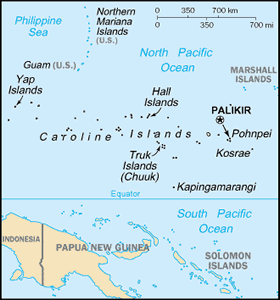The Geography of Micronesia, Federated States of
The Geography of Micronesia, Federated States of
Micronesian; Chuukese, Kosraen(s Geography
Location: Oceania, island group in the North Pacific Ocean, about three-quarters of the way from Hawaii to Indonesia
Geographic coordinates: 6 55 N, 158 15 E
Map references: Oceania
Area: total: 702 sq km land: 702 sq km water: 0 sq km (fresh water only) note: includes Pohnpei (Ponape), Chuuk (Truk) Islands, Yap Islands, and Kosrae (Kosaie)
Area - comparative: four times the size of Washington, DC (land area only)
Land boundaries: 0 km
Coastline: 6,112 km
Maritime claims: territorial sea: 12 nm exclusive economic zone: 200 nm
Climate: tropical; heavy year-round rainfall, especially in the eastern islands; located on southern edge of the typhoon belt with occasionally severe damage
Terrain: islands vary geologically from high mountainous islands to low, coral atolls; volcanic outcroppings on Pohnpei, Kosrae, and Chuuk
Elevation extremes: lowest point: Pacific Ocean 0 m highest point: Dolohmwar (Totolom) 791 m
Natural resources: forests, marine products, deep-seabed minerals, phosphate
Land use: arable land: 5.71% permanent crops: 45.71% other: 48.58% (2005)
Irrigated land: NA
Natural hazards: typhoons (June to December)
Environment - current issues: overfishing, climate change, pollution
Environment - international agreements: party to: Biodiversity, Climate Change, Climate Change-Kyoto Protocol, Desertification, Hazardous Wastes, Law of the Sea, Ozone Layer Protection signed, but not ratified: none of the selected agreements
Geography - note: four major island groups totaling 607 islands


